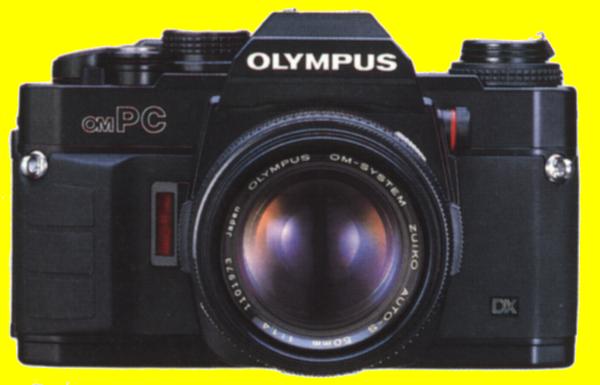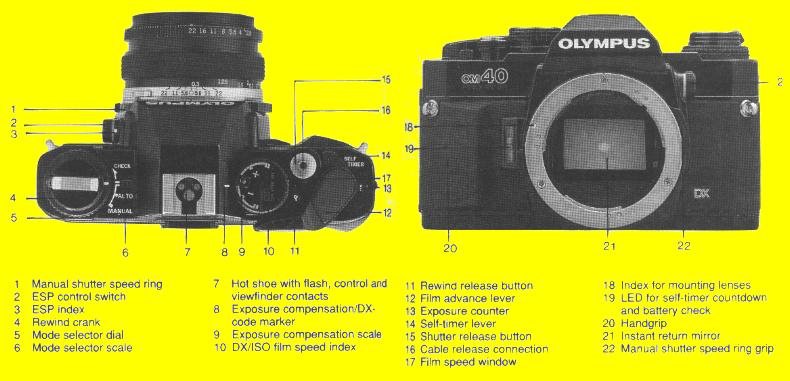
Body group OM-40 Program (US: OM-PC)
The OM-40 Program is not a further extension of the OM-30. There are no In-Focus
indicators and there is no dedicated support for an AF lens. Instead, based on the OM-20,
it adds other things that are probably of more interest for most photographers. The two
most important new features are TTL flash control (a function already available in the
OM-2, but that was stripped from the OM-10) and ESP metering. ESP stands for
Electro-Selective Pattern and is an early form of matrix metering that works with two
zones. The centre and the edges of the picture are measured independently, and when big
differences in EVs are found, the exposure is corrected. This can protect the photographer
from notorious traps like dark dressed, not frame-filling persons standing in front of
white walls. Other features that were new compared to the OM-20 is an extended ASA range
(up to 3200 instead of 1600), Program exposure (the same as on the OM-2SP) and overridable
DX-decoding that reads the film speed from the cassettes.
When you activate all new features and remember to stop down the lens well enough in order
for the Program mode to select small apertures when needed, all the photographer has to do
is frame, focus and shoot, and in most cases the picture will be properly exposed. There's
nothing wrong with this approach. Many, if not most pictures don't really depend on a
delicated and carefully selected combination of shutter speed and aperture. As long as the
combination makes a "proper" exposure in most cases correct focusing and framing
are more important and in some cases also the moment of exposure, "the decisive
moment". It must be said however that Program mode certainly is not the most
recommended mode for TTL flash exposure. The Program will always select the same aperture:
three stops from maximum aperture, and for very short or very long distances this probably
will be wrong.
The OM-40 was only available in black.


Main specifications
| Unit type: 35mm SLR Reflex with automatix exposure control, electronic focal plane shutter. | Focusing screen: Fixed microprism/split image-matte type 1-13. |
| Film format: 24mmx36mm. | Finder view-field: 93% of actual picture field. |
| Lens mount: Olympus OM Mount, bayonet type. | Viewfinder magnification: 0.92X with 50mm lens at infinity. |
| Shutter: Focal plane shutter, automatic exposure control from 2 seconds to 1/1000 second (ASA 100, F1.2 at normal temperature and humidity). | Indicators in viewfinder: 12-step shutter speed scale, indicated by
LEDs. Mode indicator (Manual / Program). Over / under exposure warning, exposure
correction indicator (+/-). Indicator in Program Mode to remind the photographer to select
the smallest aperture. ESP activation indicator. Flash ready / flash ok indicator in combination with T series flash. |
| Synchro: X contact. Direct contact only. In combination with a T series flash the 1/60 synchro speed is automatically selected. | Reflex mirror: Oversize, quick return mirror. |
| Automatic exposure control: Aperture-priority electronically
controlled shutter. TTL Direct (OTF) Light Measuring system. Measuring range: EV-0.5~EV18 from 2 sec. to 1/1000 sec. at normal temperatures and humidity with ASA 100 and F1.2 50mm. lens. Exposure compensation: ±2 EV (unavailable with DX film speed setting). Metering switchable (by means of ESP control switch) between center weighted averaging and ESP (Electro-Selective Pattern). Automatic flash exposure: direct contacts for TTL Auto Flash. |
Film advance: Lever type with 130° angle. It can be wound with one
long or several short strokes, 30° pre-advance angle. Power winding is possible with
Winder 1 or Winder 2. With Motor Drive 1 or 2 unit attached, single frame and continuous advance at speed of 3.5 frames per second (at exposures of 1/500 sec. and above, with fresh batteries and at normal temperature and humidity). With Motor Drive 2, advance to first frame after load is supported, but not power rewind. |
| Program exposure control: Measuring range identical to Automatic
exposure control. Both shutter speed and aperture are selected by the OM-40. The smallest
aperture that can be selected is determined by the aperture setting of the lens. To enable all apertures the lens must be set at the smallest aperture. |
Exposure counter: Progressive type with automatic reset when camera back is opened. |
| Manual exposure control: 1-1/1000 sec., ring mounted control. | Film rewind: Crank type, with rewind release lever setting, automatic return. |
| Film speed setting: ASA 25-3200, selectable automatic DX decoding or manually set. | Self-timer: Electronic self-timer with about 12 second delay. |
| Battery check: Battery voltage can be checked by both LED and PCV (acoustic signal). Mirror lock to limit drainage. | Accessory shoe: Built-in type, with X-contact and contacts for TTL Auto Flash and flash ready / flash ok signal with T series flash. |
| Power source: Two 1.5 silver oxide batteries SR44 (Eveready or UCAR EPX-76 or equivalent). | Dimensions and weights: Body only: 135.5x86x53mm, 460g. |
| Viewfinder: Pentaprism type. |